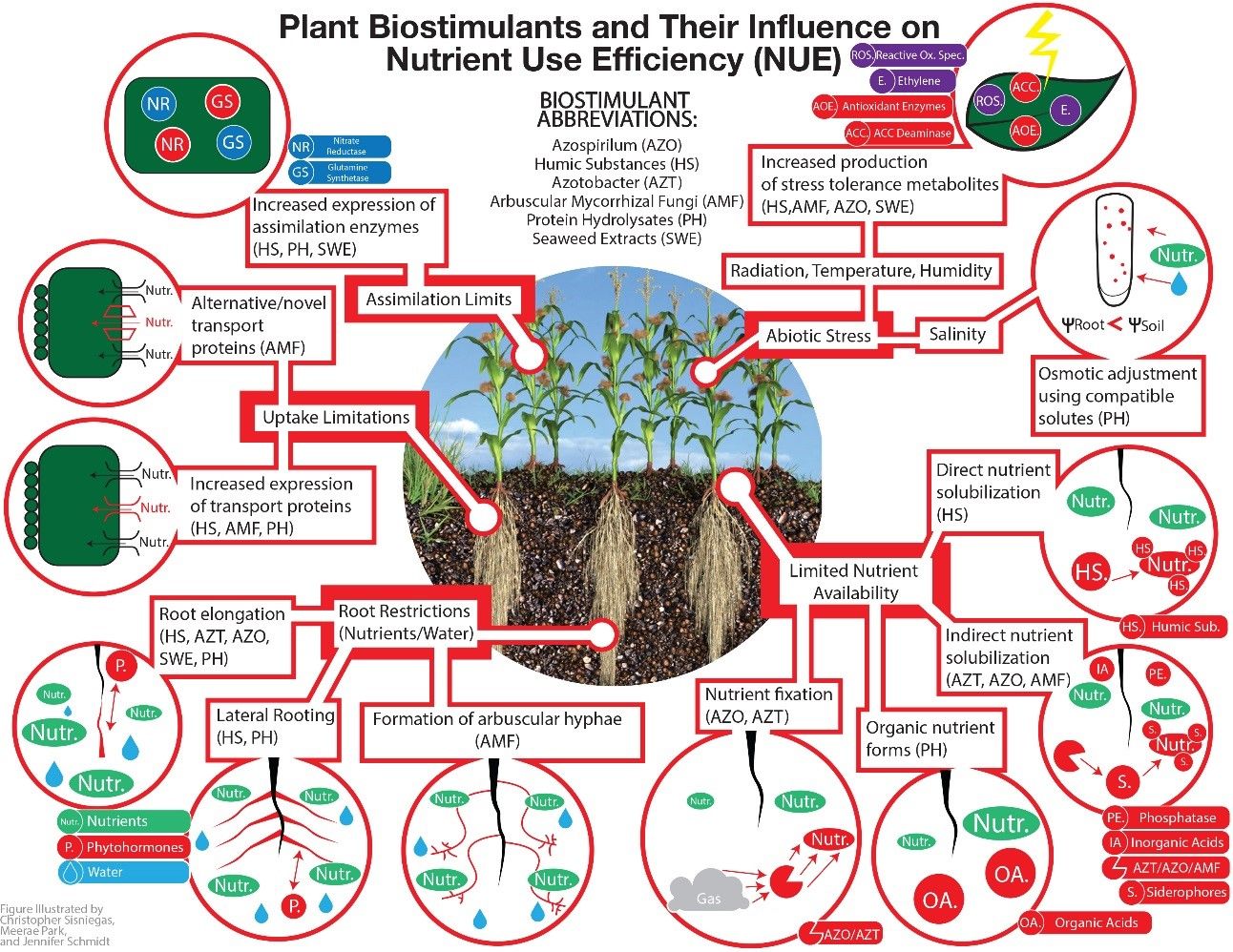BLOG #13

What are they?
Biostimulants stimulate natural processes in crops to enhance nutrient uptake, nutrient use efficiency (NUE), resistance to abiotic stress and quality traits, as well as increasing the presence of nutrients in the soil or rhizosphere.
Various types of biostimulants currently exist that claim to stimulate the natural nutrition processes of plants and crops. These include:
- Humic substances
- Seaweed extracts
- Protein hydrolysates
- Silicon
- Plant growth-promoting rhizobacteria (PGPR)
- Arbuscular mycorrhizal fungi (AMF)

Why are they important?
With growing concerns about the environmental impact of the agricultural sector and its production systems, there is an urgent need to develop more sustainable, environmentally friendly crop production processes.
Plant biostimulants claim to improve nutrient use, uptake and utilization efficiency. With this in mind, there is less of a requirement for farmers and producers to rely on the use of synthetic fertilizers to increase the quality of their products. As with other synthetic products, such as synthetic fungicides, synthetic fertilizers contribute negatively to the environment. For example, synthetic fertilizers:
- Drain away from soil into major bodies of water (lakes, streams, rivers, etc) and can impact aquatic ecosystems
- Kill beneficial microorganisms in the soil that can convert plant remains into high quality, nutritious organic matter
A key thing to note here is that biostimulants shouldn’t be used as a substitute for fertilizers. Instead, those working in the sector suggest that biostimulants should be used as an addendum to fertilizers.
With this approach in mind, lower quantities of fertilizer are required due to the capabilities of biostimulants to improve nutrient use efficiency (NUE). With lower quantities of fertilizer needed, the potential environmental impact of crop production systems is reduced.
Biostimulants are also known to enhance the tolerance of plants and crops to abiotic stresses, such as drought, salinity and instances of exposure to extreme temperatures.
In addition to this, those working within the biostimulants sector note that there is clear ability to exploit by-products of the agri-industrial sector and utilise them in the developmental stages of creating current and/or new biostimulant products.
What is the key challenge?
Despite the agricultural sector’s use of biostimulants for decades, there are – to this day – multiple definitions on the classification of biostimulants and how they function. This in part due to the divide of continents and their differing claims on the capabilities of biostimulants in improving overall crop/plant health and nutrition.
In Europe, as made claim to in Regulation (EU) 2019/1009 of the European Parliament and of the Council of 5 June 2019 laying down rules on the making available on the market of EU fertilising products, biostimulants are defined as:
‘…an EU fertilising product the function of which is to stimulate plant nutrition processes independently of the product’s nutrient content with the sole aim of improving one or more of the following characteristics of the plant or the plant rhizosphere:’
- Nutrient use efficiency
- Tolerance to abiotic stress
- Quality traits, or
- Availability of confined nutrients in the soil or rhizosphere
However, in North America, two key definitions co-exist. The first, proposed by Congress in the 2018 farm bill define biostimulants as:
‘a substance or micro-organism that, when applied to seeds, plants or the rhizosphere, stimulates natural processes to enhance or benefit nutrient uptake, nutrient efficiency, tolerance to abiotic stress, or crop quality and yield.’
The second definition, proposed by the Environmental Protection Agency (EPA) in their 2019 draft guidance define biostimulants as:
‘a naturally-occurring substance or microbe that is used either by itself or in combination with other naturally-occurring substances or microbes for the purpose of stimulating natural processes in plants or in the soil in order to, among other things, improve nutrient and/or water use efficiency by plants, help plants tolerate abiotic stress, or improve the physical, chemical, and/or biological characteristics of the soil as a medium for plant growth.’
Lack of clarity
Although some may argue that the difference between all three definitions is minimal, it’s key to highlight that the sector’s inability to settle on a definition universally recognisable by producers, farmers, and other major players worldwide, suggests that there may be uncertainty over the true understanding of what biostimulants are and the practicalities of their use.
What is the future?
The point of widespread implementation of biostimulants seems to be something of the future, but nonetheless an exciting prospect. Before the shift is made, however, it’s key that the biostimulants sector must settle on one definition to avoid confusion and ensure that a certain level of clarification is met.
With the development and wide-scale implementation throughout agriculture of advanced technologies, such as artificial intelligence, machine learning and robotics, there are suggestions that the biostimulants sector could utilise these technologies to propel the sector’s own advancement.
A key promising aspect to note is the potential ability of artificial intelligence to be utilised as a means of identifying new raw materials or microbial strains based on previous evidence and prior knowledge.
‘Biostimulants for sustainable crop production’. Youssef Rouphael; Patrick du Jardin; Patrick Brown; Stefania De Pascale and Giuseppe Colla (ed), 2020, Burleigh Dodds Science Publishing, Cambridge, UK (ISBN: 978-1-786-76336-5; https://bdspublishing.com)
We are pleased to have obtained a 20% discount for friends of biostimulant.com: https://shop.bdspublishing.com/store/bds/detail/workgroup/3-190-84222 (use code BIOST20)










